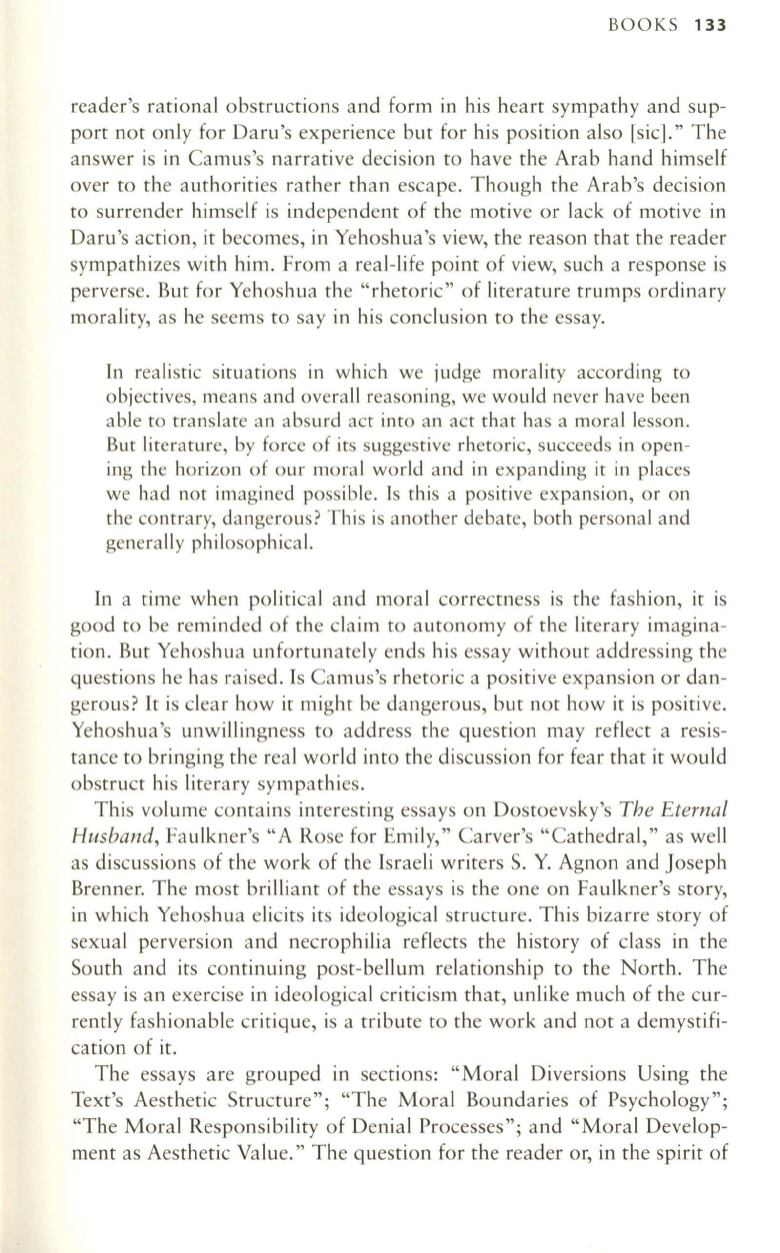
BOOKS
133
reader's rational obstructions and form in his heart sympathy and sup–
port not only for Daru's experience but for his position also [sic]." The
answer is in Camus's narrative decision to have the Arab hand himself
over to the authorities rather than escape. Though the Arab's decision
to surrender himself is independent of the motive or lack of motive in
Daru's action, it becomes, in Yehoshua's view, the reason that the reader
sympathizes with him. From a real-life point of view, such a response is
perverse. But for Yehoshua the "rhetoric" of literature trumps ordinary
morality, as he seems to say in his conclusion to the essay.
In realistic situations in which we judge morality according to
objectives, means and overall reasoning, we would never have been
able to translate an absurd act into an act that has a moral lesson.
But literature, by force of its suggestive rhetoric, succeeds in open–
ing the horizon of our moral world and in expanding it in places
we had not imagined possible. Is this a positive expansion, or on
the contrary, dangerous? This is another debate, both personal and
generally philosophical.
In a time when political and moral correctness is the fashion, it is
good to be reminded of the claim to autonomy of the literary imagina–
tion. But Yehoshua unfortunately ends his essay without addressing the
questions he has raised. Is Camus's rhetoric a positive expansion or dan–
gerous?
It
is clear how it might be dangerous, but not how it is positive.
Yehoshua's unwillingness to address the question may reflect a resis–
tance to bringing the real world into the discussion for fear that it would
obstruct his literary sympathies.
This volume contains interesting essays on Dostoevsky's
The Eternal
Husband,
Faulkner's "A Rose for Emily," Carver's "Cathedral," as well
as discussions of the work of the Israeli writers S.
Y.
Agnon and Joseph
Brenner. The most brilliant of the essays is the one on Faulkner's story,
in which Yehoshua elicits its ideological structure. This bizarre story of
sexual perversion and necrophilia reflects the history of class in the
South and its continuing post-bellum relationship to the North. The
essay is an exercise in ideological criticism that, unlike much of the cur–
rently fashionable critique, is a tribute to the work and not a demystifi–
cation of it.
The essays are grouped in sections: "Moral Diversions Using the
Text's Aesthetic Structure"; "The Moral Boundaries of Psychology";
"The Moral Responsibility of Denial Processes"; and "Moral Develop–
ment as Aesthetic Value." The question for the reader or, in the spirit of


